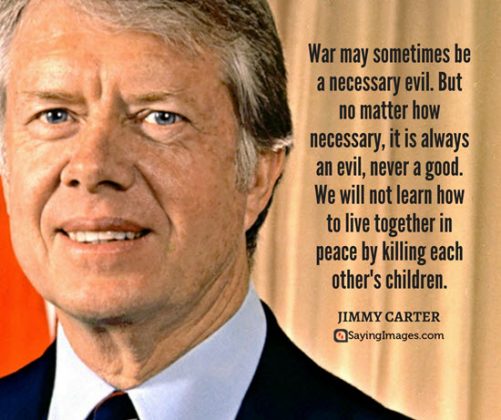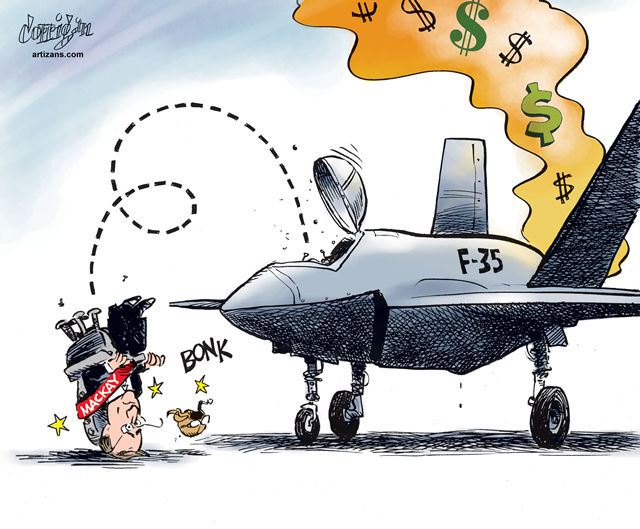
What Does Military Contracting Tell Us
About the Priorities of the Ruling Class?
Christian Sorensen / The Business of War
(September 15, 2023) — The American public is hurting. The bare necessities — clean water, nutritious food, and affordable housing — are hard to come by.
Tap water is contaminated with lead, PFAS, and other pollutants. The water systems that serve cities and towns suffer additional stressors, including drought, overuse, and a failure to incorporate greywater systems. And, like many necessities, you have to pay for it in the United States: Water utility prices continue to go up and up.
Hunger is a severe problem. Insufficient money and/or access means that millions of families regularly go hungry. Massive corporations dominate what is available in a grocery store, and much of what they produce is innutritious. Private equity firms are even allowed to purchase grocery chains and milk more profit out of the provision of food.
Housing is prohibitively expensive. Evictions are commonplace. Homelessness is rampant and increasing. The number of people without shelter jumped 11% over the past year, the largest increase in at least 15 years.
What is US Congress doing as the public suffers?

Water: A great driver of global conflict.
Water Is Not a Priority
Every year, US Congress appropriates money for two federal water funds. The Environmental Protection Agency gives this money to states in the form of grants. The Washington Post recently reported, “Since 2022, the federal allocation has totaled roughly $5.5 billion, amounting to a literal and figurative drop in the bucket for a nation with an estimated $625 billion backlog in projects just to provide cleaner, reliable drinking water.”
In other words, Congress has allocated 0.88 percent of the funding needed to establish infrastructure that dependably provides potable water.
It gets worse. Members of Congress skim funds off the top. “Using a legislative tool known as earmarks, lawmakers can reserve federal water aid for specific projects in their home communities,” the Post explained. “Only after that does Washington divvy up and distribute a smaller pool of remaining cash among the states.”
And how much of this water funding has Congress earmarked? Roughly $2.3 billion toward “pet projects over the past two years, cutting at times into the money that could have been made available for poorer, needier communities. As a result, 38 states and territories have been shortchanged about $660 million in federal water aid…”

Food is Not a Priority
Stephen Semler, co-founder of the Security Policy Reform Institute, recently showed that annual US military spending increased during the Trump administration by 20 percent in nominal terms and then increased during the first two years of the Biden administration by 15 percent in real terms. The military budget is now a record $858 billion for fiscal 2023, a bipartisan feat.
Food insecurity “climbed 18 percent during the same stretch,” Semler explained. “Something’s wrong when either military spending or food insecurity spikes over a two-year period. When they soar in tandem, it’s an abomination…”
There is plenty of money available to make sure people don’t go hungry. For example, the amount of money to be spent over several years on new land-based nuclear weapons ($263.9 billion) could instead build 52.5 million community gardens ($2,750 each) across the country, with more than enough money left over ($119.52 billion) to cover a year of food stamps. Tax dollars, we see, could be used to nourish instead of accidentally or deliberately eliminating human life on Earth.

The Housing Crisis
The federal government regularly demonstrates its construction priorities. On a single day in April of this year, $221.6 million was announced for military construction on Tinian in the Northern Marianas. On a single day in May, $562 million was announced for supplies going toward the upkeep of military facilities in the Indian and Pacific oceans. On a single day in June, $1.149 billion was announced for new military construction in the Middle East. Construction is one of the most common categories of military contracting.
What do these priorities sacrifice?
- That single April expenditure could have paid off the student debt of 7,654 people (average $28,950owed), liberating them from a crushing burden.
- That single May expenditure could have replaced 119,574 lead pipe service lines (average $4,700replacement).
- That single June expenditure could have provided a year of public housing for 135,176 people (average $8,500cost).
Bombs and missiles on Guam get brand-new housing (e.g., 1, 2, 3, 4, 5) while thousands of people lack housing in the US capital.

Support the Troops
Evidence suggests that the federal government doesn’t even prioritize the troops’ water, food, and housing.
It is wise to avoid drinking the water when near any military base, former or current. Thousands of polluted formerly used defense sites (FUDS) pockmark the country. Additionally, military use of “forever chemicals” pollutes tap water, groundwater, and soil at numerous active bases. (Military leaders’ lies about the troops’ health — including but certainly not limited to lies regarding chemical and biological testing, the defoliant known as Agent Orange, chemical dumping, burn pits, and the recent fuel leak that polluted the Navy’s water system on O‘ahu — encourage one to always question authority.)
Hunger remains a serious problem in military families.
Like most aspects of military function, the US government has placed military housing in corporate hands. As any current or former member of the US Armed Forces can tell you, military housing leaves a lot to be desired. Housing corporations are not above defrauding the military. Some (A and B) get caught.
Military veterans suffer high rates of homelessness, unlike those who excel in the business of war. Marillyn Hewson lived in a mansion in northern Virginia during her time as chief executive of Lockheed Martin. Private equity billionaires — including Carlyle Group founders William Conway Jr. of McLean, Virginia, and David Rubenstein, of Bethesda, Maryland — bask in luxury.

A State of Permanent Warfare
Military and intelligence personnel don’t deploy themselves. The US ruling classdeploys them.
When “successful,” military or intelligence operations open up an economy to multinational corporations, enriching the ruling class. Examples spanning the three main eras of the military-industrial complex (the first Cold War, the “global war on terror”, and today’s “strategic competition”) illustrate this success:
- In the 1960s, US intelligence agenciesfacilitated the mass killing of Indonesian workers, union organizers, and Indonesians who wanted Indonesians to determine the fate of Indonesian resources and labor.
- Early in the US occupation of Iraq, US viceroy Paul Bremer issued edicts thatopened up Iraq’s economy — from agriculture to telecommunications — to multinational corporations.
- Massive US-based financial firms arealready planning the reconstruction of Ukraine, which is currently being destroyed in an “unprovoked” war that profits Western business interests (A, B, C, D). The bar is set high: 80-90% of the billions allocated for the reconstruction of Afghanistan actually went straight back into US corporations, Professor C. Christine Fair explains in Foreign Policy. A JPMorgan executive has deemed Ukraine’s reconstruction a “tremendous opportunity.”
Moreover, US military activity itself is extremely profitable for Wall Street and top corporate executives, as the US military doesn’t shoot, move, or communicate — let alone eat, refuel, fly, or spy — without corporate goods and services. Corporations absorb more than half of the US military budget. Many regularly price gouge the military.
The ruling class is organized and relentless in its pursuit of profit. The three branches of government (legislative, judicial, executive) largely respond to the needs of this class. Some of the richest and/or most influential members of US government, such as a coal baron or a person who has profited from the provision of healthcare, even come from that class.

The F-35. A $1.7 Trillion Failure.
The Front Burner
A military aircraft, the F-35 Joint Strike Fighter, embodies the priorities of the ruling class. With a lifetime cost expected to top $1.7 trillion, the F-35 is on track to becoming the most expensive weapon of all time. The aircraft does not function as marketed. It reportedly is not allowed to fly when cumulonimbus clouds are nearby, has shot itself with its own gun, suffers from debilitating software problems (A, B), and has an engine that struggles to perform again and again. The manufacturer reportedly does not even intend to address 162 of the aircraft’s 883 known design flaws.
Though the aircraft does not perform as marketed, it does perform its role well within the economic system by bringing in billions every year to the large corporations involved. Stock dividends are paid regularly, top executives are compensated eight figures, and corporations buy back stock to increase share price.
In a democracy, elected officials would respond to the dire needs of the working class by cancelling an overbudget underperforming weapon and redirecting the relevant funds toward public good. In an economic system designed to profit the ruling class, not care for the working class, the F-35 is fully funded. In July alone, tax dollars set aside for the F-35 amounted to $977,213,437, according to contracting announcements (1, 2, 3, 4, 5, 6, 7). This figure does not even include sales to allied governments.
One year of F-35 spending could provide a year of healthcare for 4.15 million children or it could cover a year of public housing for 1.42 million families. For the cost of another aircraft carrier that struggles to launch aircraft ($12.6 billion), the US government could instead offer four-year university scholarships to roughly 337,000 young adults.
One-Two Punch
The military-industrial complex is a one-two punch to the public.
- The US poor and working class fight the wars. Those who profit from war do not fight the wars. Moreover, the peasants and workers of the world on the receiving end of US military and intelligence operations, which the US ruling class orders and oversees, suffer greatly, particularly in terms of lives lost and environmental devastation.
- Tax dollars that could be going to helpful programs (food, water, shelter, education, debt relief, healthcare, infrastructure) are directed instead to elective war. There is plenty of money to care for the public. Doing so, however, does not enrich the ruling class like the military-industrial complex does.
The Costs of War Project explains in gentler terms how the ruling class’ priorities add up over time:
Military spending makes up a dominant share of discretionary spending in the United States; military personnel make up the majority of US government manpower; and military industry is a leading force in the US economy…
[A]s a result, other elements and capacities of the US government and civilian economy have been weakened, and military industries have gained political power… Investments in infrastructure, healthcare, education, and emergency preparedness, for instance, have all suffered as military spending and industry have crowded them out.
Human security is deteriorating and life expectancy falling. As demonstrated, clean water, healthy food, and affordable housing are hard to come by. Public infrastructure crumbles. Despair is widespread.
The military-industrial complex ends when the working class says it ends. The ruling class dreads a united working class, because a united working class can use superior numbers to push back against the profit-over-people economic system known as capitalism.
An assertive, united working class could redirect tax dollars away from the business of war and into helpful programs (e.g., healthcare, education, infrastructure, housing ), even going as far as fully converting the business of war into endeavors that actually benefit humanity, such as public transportation, disaster relief, international scientific cooperation, R&D of energy capture and storage.
Given the intertwined mass extinction and climate crises in which we are living, it is imperative that the working class unites across racial lines and gets to work.
Christian Sorensen is a researcher focused on the business of war. He is the foremost authority on the bundling of military and big business. A US Air Force veteran, he is the author of the book Understanding the War Industry (Clarity Press, 2020). His work is available at warindustrymuster.com. Sorensen is a senior fellow at the Eisenhower Media Network (EMN), an organization of independent veteran military and national security experts who understand that US foreign policy is not making them, or the world, safer.
Posted in accordance with Title 17, Section 107, US Code, for noncommercial, educational purposes.